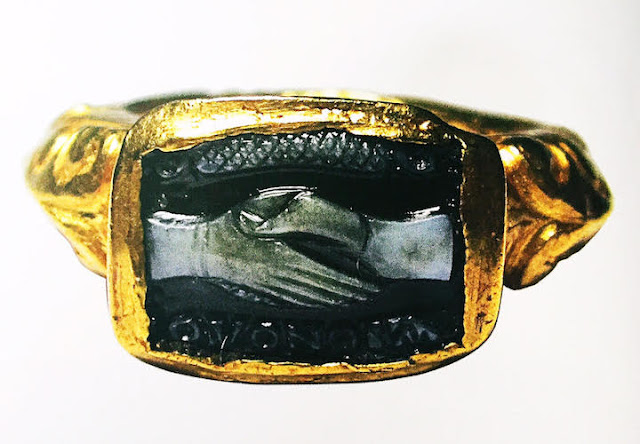Ancient Egyptian papyrus scrolls dating to 6,000 years ago, depict the exchange of braided rings of hemp or reeds between spouses. These bands were eventually replaced by circlets of leather, bone, or ivory. Ancient Egypt considered the circle to be a symbol of eternity, and the ring served to signify the perpetual love of the spouses. This was also the origin of the custom of wearing the wedding ring on the ring finger of the left hand, because the ancient Egyptians believed that this finger enclosed a special vein that was connected directly to the heart, in Latin the "Vena amoris".
In ancient Greece and Rome betrothal rings resembling signet rings were introduced, most commonly with a a "fede" ring, depicting two hands clasping in love or agreement - dextrarum iunctio. Initially, the ring was given by the groom to the father of the bride to serve as a symbol of bride purchase. By the second century BCE, however, the ring was given to the bride to indicate the groom trusted her with his valuable property. Although a gold ring, sometimes inset with carved carnelian, aquamarine, garnet, or onyx, was worn in public to display the husband's wealth and status, it was replaced by an iron ring, called the Anulus Pronubus, at home. These iron rings sometimes were formed in the shape of a key to represent control over the household possessions. Iron rings plated with gold have also been found.
The design eventually evolved to depict carvings of the couple themselves. Although such rings were initially considered a pagan tradition, when Christianity was adopted as the state religion and representatives of the church began performing official marriages, rings were once more exchanged but religious images were incorporated into ring designs. Sometimes inscriptions were included as well. One example in the British Museum is inscribed "Te amo parum" - "I love you too little" or "I do not love you enough".
One of the first-known uncut diamond rings is dated to the 100s CE and found in Rome. However, its association with love or marriage is unknown. The first documented diamond betrothal ring was exchanged in 1475 at the wedding of Costanzo Sforza and Camilla D'Aragona in Italy. Their wedding poem read “Two wills, two hearts, two passions are bonded in one marriage by a diamond.”
Earlier this year when I studied the Black Death we also discussed the development of artwork featuring "memento mori" skeletal images. I was surprised to discover Renaissance-era gimmel marriage rings included memento mori in their artwork.
To learn more about the history of the wedding ring check out:
http://withtheseringshandmade.com/history-of-wedding-rings
 |
| Early Byzantine silver marriage ring with wedding couple in profile, 375-425 CE, at the Royal Ontario Museum in Toronto, Canada courtesy of the museum. |
 |
| Renaissance-era Gimmel-style marriage with with memento mori imagery at The Metropolitan Museum of Art courtesy of the museum. |
 |
| A 6th-7th century gold marriage ring with couple depicted at The Metropolitan Museum of Art courtesy of the museum. |
 |
| A 6th century gold and niello Byzantine marriage ring depicting scenes from the life of Christ at the Walters Art Museum courtesy of the museum. |
 |
| A 6th century gold and niello Byzantine marriage ring depicting scenes from the life of Christ at the Walters Art Museum courtesy of the museum. |
 |
| Gold and onyx 3rd century CE Roman "fede" ring. |
 |
| 1st century CE Roman "key" ring at the Vidy Roman Museum near Lausanne, Switzerland courtesy of Wikimedia Commons contributor Rama. |
No comments:
Post a Comment